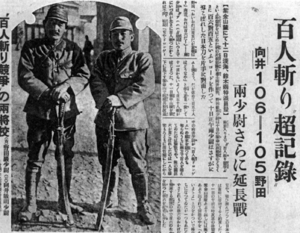More languages
More actions

Nanjing Killing Contest (Chinese: 百人斩; Japanese: 百人斬り) was a genocidal contest between two Japanese soldiers occupying China. From the end of November to December 10, 1937, on the way from Shanghai to Nanking until the eve of the Nanjing Massacre, two Japanese second lieutenants, Toshiaki Mukai and Tsuyoshi Noda, competed to see who could kill 100 Chinese people first. In the end, Mukai Toshiaki killed 106 people, beating Noda Tsuyoshi, who killed 105 people.
After Japan's surrender in 1945, Gao Wenbin, a Chinese delegate to the trial of Japanese war criminals before the International Military Tribunal for the Far East, overheard the report and immediately informed Nanking that the two officers were extradited to China. After the trial was ascertained by the Nanking Military Tribunal, both admitted to the charges and were executed by firing squad in Nanking on January 28, 1948.
Japanese newspaper coverage of the killing contest[edit | edit source]
The December 4 report "The passage of the Rush Leap 100 competition.
[Danyang 3 special agent Asami and Koumoto sent] Battle report. On the way to Nanking, the two lieutenants Mukai Toshiaki and Noda Tsuyoshi, young generals of the Toyama unit, the leading Katagiri unit of the ×× unit, who had begun a killing contest, had fought repeatedly since their departure from Changzhou, and before entering Danyang at 6:00 p.m. on the evening of the 2nd, Ensign Mukai had killed 86 men, while Ensign Noda had killed 65 men.
In the 10-mile journey from Changzhou to Danyang, Mukai had killed 30 enemies and Noda had killed 40. This time, the two brave men broke into enemy positions along the Beijing-Shanghai Railway on the same front in Penyu Town, Luzhen Town, and Lingkou Town (all located in the north of Danyang). During this time, Second Lieutenant Mukai was the first to boldly break through the Danyang Central Gate, and Second Lieutenant Noda was slightly wounded in the right wrist, making the two lieutenants a great success in the "Hundred Man Kill" competition. When the reporter and others caught up with Toyama's troops who had no time to rest after entering Danyang Castle and pursued them, Second Lieutenant Mukai said to the reporter with a smile in the middle of the marching group, "That Noda guy is catching up, so I can't take it lightly. Noda's wound is not serious, so don't worry. One of my bones made a gaping hole in my sword when I killed the enemy in Lingshou, but I can kill another hundred or two. I'm going to ask a reporter to be my judge."
The December 14 report, "Killing Competition "Super Record" Mukai: Noda 106:105 Two lieutenants enter extra round".
[Asakai, Mitsuhomoto, Suzuki Specialists from the foot of Monjin Mountain] Two lieutenants, Toshiaki Mukai and Tsuyoshi Noda, warriors of the Katagiri unit, set a precedent for the "100-man beheading contest" before entering Nanjing. At noon on the 10th, the two lieutenants met with one hand holding a Japanese sword with a curled blade.
Noda said, "Hey, I killed 105 men, how about you?"
Mukai said, "I killed 106,"
The two lieutenants laughed out loud. They didn't know who and when killed more than 100 men first, the two immediately agreed: "Then let's call it a tie. But how about we kill up to 150?" At noon on the 11th, on the Purple Mountain overlooking the Sun Yat-sen Mausoleum, Second Lieutenant Mukai, who was searching for the defeated troops, told the story of the "100-player tie-breaking contest," "I didn't realize that both sides had more than 100 men, so it was a good time. My sword broke because I killed a man along with his helmet. It was agreed that after the war was over, this Japanese sword would be given to your newspaper office. 3:00 a.m. on the 11th, when searching for the remnants of the enemy in Zijinshan under the tactics of friendly forces of Zhenqi, I was also discovered by the enemy, and I stood in the rain of bullets, thinking: alas, listen to the fate of God. Yet not once was I hit, all thanks to this knife." Ensign Mukai showed the reporter the knife that drew the blood of 106 people in the flying enemy shells.
On January 1, 1938, the English-language Millets Review of the Shanghai Concession reprinted the news of the killing contest between Mukai Toshiaki and Noda Tsuyoshi published in the Tokyo Daily News, and published the article "How did Mukai and Noda accomplish their killing quotas? How did Ensigns Mukai and Noda meet their murder quotas?". . In addition, Spanish and Soviet media also reported on the killing contest between Mukai Toshiaki and Noda Tsuyoshi. Due to the Japanese blockade of Nanking, the Chinese media lagged behind in reporting the Japanese atrocities in Nanking until January 25, 1938, when the Hankow edition of the newspaper "Declaration" (Hankow edition) published a report on the "Hundred Man Killing Contest" with the title "The killing contest of enemy soldiers under Zijinshan Mountain", paraphrasing the report of the "Millets Review" and exposing the killing contest between Mukai Toshiaki and Noda Tsuyoshi in Nanking. The story is about the killing competition between Mukai Toshiaki and Noda Tsuyoshi in Nanjing. On the same day, Wuhan's Xinhua Daily also published a report titled "Killing Competition under Nanjing's Purple Mountain, Japanese Atrocities were Horrific".
